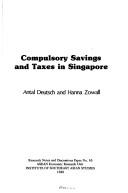| Listing 1 - 10 of 106 | << page >> |
Sort by
|
Book
ISBN: 9264289399 9264289372 9789264289390 Publisher: OECD Publishing
Abstract | Keywords | Export | Availability | Bookmark
 Loading...
Loading...Choose an application
- Reference Manager
- EndNote
- RefWorks (Direct export to RefWorks)
This report assesses the performance of all components of Latvia's pension system. Latvia was the first country to fully implement a non-financial (notional) defined contribution (NDC) scheme in 1996. A funded mandatory earnings-related scheme complemented NDC since 2001. Voluntary private pensions cover only limited number of people. Over the last 20 years, the severe economic crisis, population ageing and strong emigration have revealed both strengths and weaknesses of the Latvian pension system. The review assesses also the minimum and basic pension schemes which provide the first-layer of protection against the old age poverty especially for those with short or patchy careers. Separate analysis focuses on the disability and early retirement schemes, including the schemes for workers in arduous and hazardous occupations. The detailed analysis leads to tailored recommendations on how to improve the performance of each element as well as the pension system as a whole.
Pension trusts --- Investments --- Employee pension trusts --- Pension funds --- Pension plans --- Trusts and trustees
Book
ISBN: 9264267794 9264265317 9264265309 Year: 2016 Publisher: Paris : OECD,
Abstract | Keywords | Export | Availability | Bookmark
 Loading...
Loading...Choose an application
- Reference Manager
- EndNote
- RefWorks (Direct export to RefWorks)
This publication helps policy makers to better understand annuity products and the guarantees they provide in order to optimise the role that these products can play in financing retirement. Product design is a crucial factor in the potential role of annuity products within the pension system, along with the cost and demand for these products, and the resulting risks that are borne by the annuity providers. Increasingly complex products, however, pose additional challenges concerning consumer protection. Consumers need to be aware of their options and have access to unbiased and comprehensible advice and information about these products.
Annuities. --- Retirement income --- Pension trusts. --- Planning. --- Employee pension trusts --- Pension funds --- Pension plans --- Trusts and trustees --- Investments --- Pensions

ISBN: 0199240485 9780199240470 9780199240487 0199240477 Year: 2000 Publisher: Oxford: Oxford university press,
Abstract | Keywords | Export | Availability | Bookmark
 Loading...
Loading...Choose an application
- Reference Manager
- EndNote
- RefWorks (Direct export to RefWorks)
Pension trusts --- #SBIB:35H436 --- Employee pension trusts --- Pension funds --- Pension plans --- Trusts and trustees --- Beleidssectoren: welzijn, volksgezondheid en cultuur
Book
ISBN: 1009001000 1316518639 1009007467 1009008234 9781009007467 9781009008235 9781009001007 Year: 2023 Publisher: Cambridge, England : Cambridge University Press,
Abstract | Keywords | Export | Availability | Bookmark
 Loading...
Loading...Choose an application
- Reference Manager
- EndNote
- RefWorks (Direct export to RefWorks)
Scores of lawsuits have pushed retirement plan sponsors to shorter, easier-to-navigate menus, but - as Ian Ayres and Quinn Curtis argue in this work - we've only scratched the surface of retirement plan design. Using participant-level plan data and straightforward tests, Ayres and Curtis show how plan sponsors can monitor plans for likely allocation mistakes and adapt menus to encourage success. Beginning with an overview of the problem of high costs and the first empirical evidence on retirement plan fee lawsuits, they offer an overview of the current plan landscape. They then show, based on reforms to a real plan, how streamlining menus, eliminating pitfalls, and adopting static and dynamic limits on participant allocations to certain risky assets or 'guardrails' can reduce mistakes and lead to better retirement outcomes. Focusing on plausible, easy-to-implement interventions, Retirement Guardrails shows that fiduciaries need not be limited to screening out funds but can design menus to actively promote good choices.
Pension trusts --- Trusts and trustees --- Finance --- Law and legislation --- Employee pension trusts --- Pension funds --- Pension plans --- Trusts and trustees.

ISBN: 0804745218 Year: 2001 Publisher: Stanford, Calif. Stanford University Press
Abstract | Keywords | Export | Availability | Bookmark
 Loading...
Loading...Choose an application
- Reference Manager
- EndNote
- RefWorks (Direct export to RefWorks)
Money market. Capital market --- Personnel management --- Pension trusts --- Evaluation. --- Investments. --- Management. --- -Pension trusts --- -332.67254 --- Employee pension trusts --- Pension funds --- Pension plans --- Trusts and trustees --- Management --- Investments --- Evaluation
Book
ISBN: 926422274X 9789264222748 Year: 1982 Publisher: Paris: OCDE,
Abstract | Keywords | Export | Availability | Bookmark
 Loading...
Loading...Choose an application
- Reference Manager
- EndNote
- RefWorks (Direct export to RefWorks)
Pension funds and annuity providers need to effectively manage the longevity risk they are exposed to. Individuals receiving a lifetime income may live longer than expected or accounted for in the actuarial calculations to provision for these liabilities. Mismanaged longevity risk can deteriorate finances, cause bankruptcy and expose individuals to the risk of losing their retirement income. To safeguard against this risk, pension funds and annuity providers must provision for future improvements in mortality and life expectancy. The regulatory framework can support the effective management of longevity risk. This publication assesses how pension funds, annuity providers such as life insurance companies, and the regulatory framework account for future improvements in mortality and life expectancy. The study then examines the mortality tables commonly used by pension funds and annuity providers against several well-known mortality projection models with the purpose of assessing the potential shortfall in provisions. The final part of the publication identifies best practices and discusses the management of longevity risk, putting forward a set of policy options to encourage and facilitate the management of longevity risk.
Life annuities. --- Pension trusts. --- Retirement income. --- Business & Economics --- Labor & Workers' Economics --- Employee pension trusts --- Pension funds --- Pension plans --- Annuities --- Income --- Trusts and trustees
Book
ISBN: 9789264308695 Year: 2019 Publisher: Paris : Organization for Economic Cooperation & Development,
Abstract | Keywords | Export | Availability | Bookmark
 Loading...
Loading...Choose an application
- Reference Manager
- EndNote
- RefWorks (Direct export to RefWorks)
Many of Asia’s retirement-income systems are ill prepared for the rapid population ageing that will occur over the next two decades. The demographic transition – to fewer babies and longer lives – took a century in Europe and North America. In Asia, this transition will often occur in a single generation. Asia’s pension systems need modernising urgently to ensure that they are financially sustainable and provide adequate retirement incomes. This report examines the retirement-income systems of 18 countries in the region. The report provides new data for comparing pension systems of different countries. It combines the OECD’s expertise in modelling pension entitlements with a network of national pension experts who provided detailed information at the country level, verified key results and provided feedback and input to improve the analysis.
Pensions --- Pension trusts --- Retirement income --- Income --- Employee pension trusts --- Pension funds --- Pension plans --- Trusts and trustees --- E-books --- Pension trusts. --- Retirement income.

ISBN: 9780511607196 9780521846325 9781107407213 0521846323 9780511226199 0511226195 0511222971 9780511222979 9780511224317 0511224311 9780511224980 0511224982 9786610550500 6610550506 1107164230 9781107164239 1280550503 9781280550508 0511225628 9780511225628 0511317964 9780511317965 0511607199 1107407214 Year: 2006 Publisher: Cambridge ; New York : Cambridge University Press,
Abstract | Keywords | Export | Availability | Bookmark
 Loading...
Loading...Choose an application
- Reference Manager
- EndNote
- RefWorks (Direct export to RefWorks)
This 2006 book treats two vital public policy issues: how should distributions from individual accounts be regulated, and how can the market for private annuities function better? It provides a comprehensive survey of the issues that arise when contributors to individual accounts become eligible for distributions. It also addresses the questions of whether annuitization or other restrictions on distributions should be mandatory, and if so, can the provision of annuities be privatized? Its analytical framework is applicable to a broad range of countries. Given the diminishing importance of public pensions around the world, the growing number of the elderly, and the increasing importance of defined contribution plans, the voluntary demand for private annuities is going to grow. It is vital that annuities be reasonably priced and that the annuity market be effectively regulated. The book investigates both issues, and proposes reforms to enhance the efficiency of the annuity market.
Pension trusts. --- Life annuities. --- Retirement income. --- Income --- Annuities --- Employee pension trusts --- Pension funds --- Pension plans --- Trusts and trustees --- Business, Economy and Management --- Economics

ISBN: 9814376280 9971988879 Year: 1988 Publisher: Singapore : Institute of Southeast Asian Studies,
Abstract | Keywords | Export | Availability | Bookmark
 Loading...
Loading...Choose an application
- Reference Manager
- EndNote
- RefWorks (Direct export to RefWorks)
Three of the four chapters in this book deal with consequences of the income-tax treatment of contributions to and withdrawals from the CPF. They discuss the effects on the borrowing costs of the Government of Singapore, and on the effective rates of return accruing to the citizens as members of the Central Provident Fund. The last chapter presents estimates of the probable decline in the retirement incomes of Singaporeans arising from the 1986 reduction in employer contributions.
Pension trusts --- Employee pension trusts --- Pension funds --- Pension plans --- Trusts and trustees --- Taxation --- Central Provident Fund of Singapore. --- CPF (Central Provident Fund of Singapore) --- Central Provident Fund
Book
ISBN: 0821374931 082137494X 9780821374931 9780821374948 9786611385774 1281385778 Year: 2008 Publisher: Washington D.C. : World Bank,
Abstract | Keywords | Export | Availability | Bookmark
 Loading...
Loading...Choose an application
- Reference Manager
- EndNote
- RefWorks (Direct export to RefWorks)
Risk-Based Supervision of Pension Funds provides a review of the design and experience of risk-based pension fund supervision in countries that have been leaders in the development of these methods. The utilization of risk-based methods originates primarily in the supervision of banks. In recent years it has increasingly been extended to other types of financial intermediaries, including pension funds and insurers. The trend toward risk-based supervision of pensions reflects an increasing focus on risk management in both banking and insurance based on three key elements: capital requirements,
Money market. Capital market --- Denmark --- Netherlands --- Mexico --- Australia --- Pension trusts. --- Pension trusts --- Risk --- Business & Economics --- Labor & Workers' Economics --- Management --- Risk. --- Employee pension trusts --- Pension funds --- Pension plans --- Economics --- Uncertainty --- Probabilities --- Profit --- Risk-return relationships --- Trusts and trustees
| Listing 1 - 10 of 106 | << page >> |
Sort by
|

 Search
Search Feedback
Feedback About UniCat
About UniCat  Help
Help News
News